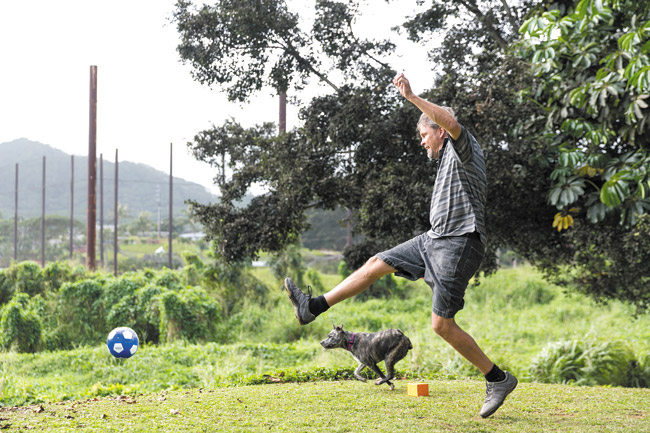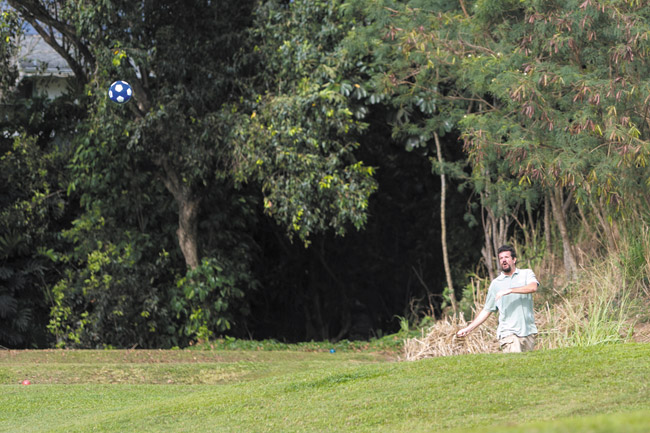Kickin’ It On The Course
Golfers know all about ‘kick-in’ birdies and ‘foot wedges,’ and now you can do just that without bending the rules at two Oahu courses, where FootGolf is taking off using soccer balls and really big holes
“Country clubs and cemeteries are the biggest wasters of prime real estate!” —Al Czervik in ‘Caddyshack’
These sentiments long have been echoed by non-golfers the world over, as they drive past huge tracts of green space they can never use, barred from nature by a few people who like to hit a little white ball with sticks ill-equipped for the purpose.
But what if there was a way for the rest of us to access these courses without learning the game Mark Twain described as “a good walk spoiled”?
Enter FootGolf, where a “kick-in” birdie and “foot wedge” literally are just that.
Started just over a decade ago in Europe as a diversion for footballers to work on their accuracy with a soccer ball, it quickly grew in popularity and transferred itself from the park to a golf course for the first time in 2008 in Holland.
The concept is simple. Using a regulation soccer ball, you use your foot as the golf club to navigate your way around the course.
The rules follow those of regular golf, as does the scoring. The least amount of kicks to complete the course is the winner.
The tee shot will remind you of the approach Adam Sandler used in Happy Gilmore, with a golfer running up at the ball, but around the green it is very similar to its much older, Scottish-born brother. Greens need to be read to account for speed and break, sand traps have to be blasted out of and cursed at, and flags need to be tended.
It has spread like a YouTube cat video across the country, and more than 300 courses in the U.S. have FootGolf available (two on this island), with formal tournaments, two different governing bodies and even whispers about attempts to make it an Olympic sport in the next decade or two.
The holes are generally shorter than an average golf hole — let’s face it, even Lionel Messi isn’t driving the ball 150 yards off the tee, much less the 300 or more generally needed in regular golf.
The hole itself is 21 inches in diameter, which corresponds to the size ratio you find between a Titleist and a golf hole. The attire matches that of regular golfers, with outrageous plaid knickers and Hogan-style caps encouraged, but players do discourage golf shoes and soccer cleats, opting rather for indoor soccer or running shoes.
There are multiple reasons for the rise of FootGolf, the first being the realities of the newest generation of Millennials and their shorter attention spans.
This, coupled with the cost of a round of golf, has seen a great reduction in the number of young people interested in spending five hours on the course.
According to National Golf Foundation, there has been a net reduction of 643 golf courses in the United States since 2006. With an older generation of golfers dying off, clubs are looking to new ways to draw in business.
The FootGolf format allows the courses to diversify their use because the installation of the foot courses does not exclude the club variety players. They both can play at the same time, with the added advantage that the foot golfers can kick up on their stick-wielding partners without fear of hurting anyone.
The foot sport also is much quicker to play, with an average round of 18 holes lasting about two hours, making it much more appealing to the hectic schedule of young people.
And the cost is so much less for the new sport. You only need one ball, which runs around $30, as opposed to the hundreds of dollars duffers spend every year losing balls in the lakes and woods of America.
Also, you come equipped with the only club you need for the sport for free, while the traditional variety spend thousands of dollars trying to find a club that will finally eliminate their slice.
Even the green fees are cheaper. Just look at the two courses on Oahu that currently offer the sport. The Fazio Course at Turtle Bay will run you as much as $105 to play a round with that dimpled white ball, but bring a No. 5 soccer ball and you can play 18 holes for just $15. Bay View Golf Park in Kaneohe charges as much as $48 for a round with a cart, but you can walk it in your Sambas for just $11 a person or utilize its ohana rate of $30 for a family of four.
All of these factors made it a no-brainer for Bay View golf pro Larry Dunn when the idea of FootGolf was suggested to him.
“We needed a way to get more people on the course,” says Dunn, who moved here last year from Florida to help revitalize Bay View’s business. “It is a great way to get the kids off the computer and outside getting some exercise and having some fun.”
He will host the first-in-Hawaii FootGolf tournament March 26, with lunch and prizes, as a way to introduce the sport to the people of Oahu. If you would like to participate, it is on Kuhio Day, so the kids will be out of school. Call Dunn at 247-0451 or email him at ldunn@bayviewgolfcourse.us.







